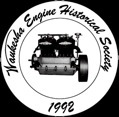The Motor Works - Part 4 (added July 2014)
The ’20s were roaring at Motor Works
 |
JOHN SCHOENKNECHT |
The decade of the 1920s ushered tremendous growth and change in the company.
Demand for tractor and truck engines continued to grow in the 1920s. According to Gib Koenig, “By 1920 the company produced engines for 30 different tractor builders. Mechanization of U.S. farms created great demands for trucks as farmers realized that ‘horse power’ was no longer a match for tractors.”
One of the most important events of the 1920s involved the company’s efforts to patent a new type of cylinder head – a device that increased the efficiency and power of their motors. It was called the Ricardo Head, and was invented and developed by Harry Ricardo of England. Horning visited Ricardo in England and the men became friends.
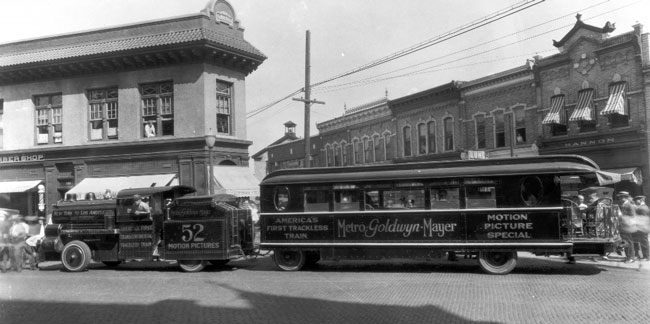 |
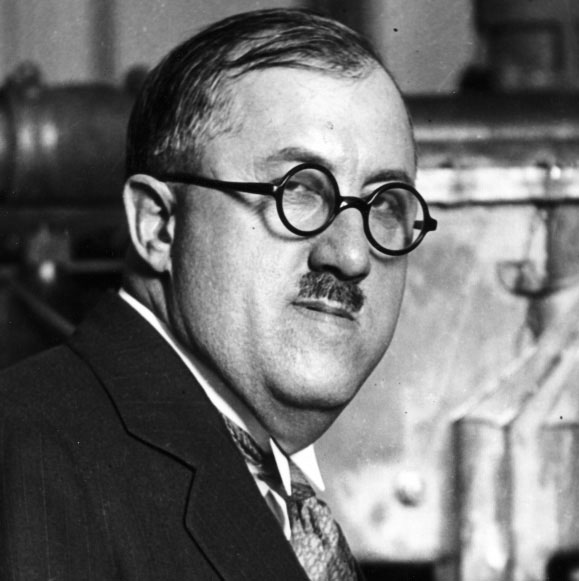 |
| Photo from John Schoenknecht collection at the Waukesha County Museum | Photo from John Schoenknecht collection at the Waukesha County Museum |
| The MGM “Trackless Train” was actually a bus and special vehicle equipped with a Waukesha motor. It stopped in Waukesha on July 23, 1925, and was photographed by Warren O’Brien. Jack Ruch, a Waukesha Motor employee, accompanied the train to Los Angeles. | Harry Horning, photographed in 1929 by Warren O’Brien. |
Prior to meeting Horning, Ricardo tried to patent his new cylinder head in the United States, but was refused a patent by the U.S. Patent Office. Several American automotive manufacturers then adapted his design without license to do so. In 1921, Ricardo allowed Horning to obtain patents for his invention (granted in 1923) and he received a cut of the profits. In return, Horning was able to use Ricardo’s invention freely and advertised “Waukesha Ricardo Head Engines.” The company even developed a kit that could be used to replace the head of existing motors with the Ricardo head.
In part, the patent read: “The construction involved is that of an L-head engine in which the combustion chamber, instead of being merely a dome in the upper end of the cylinder is an offset recess in the head, forming a pocket over the valves. This was developed according to Ricardo’s much discussed views of turbulence, and derives its virtue in part from the fact that a swirling motion is set up in the fuel mixture during combustion. This promotes more definitely controlled combustion, permits higher compression ratios to be used and thus produces more power, together with freedom from ‘pinging,’ and carbon deposition.”
New uses
A headline in the Jan. 10, 1922 Freeman declared “Motor Works Launches Aggressive Sales Effort.” The company showed its latest motors at a trade show in New York and then Chicago. The article mentioned that new industrial motors had been developed. Besides use in trucks and tractors, Waukesha motors were used on ditch diggers, air compressors, gasoline derricks, portable excavators, industrial locomotives, concrete mixers, hoists, cranes, and drag line derricks. Units were made for stationary or portable work of all kinds. Engine sizes ranged from 6 horsepower to 1,200 and weighed from 100 pounds to 16,000 pounds.
In August of 1922, a coal shortage caused the Motor Works to temporarily switch back to gasoline to test its products. The August 7, 1922, Freeman reported on a “Mid-Summer Night’s Follies” that was presented at Frame Park for employees of the company. Movies were shown and entertainment provided – including dances, musical groups, clown stunts, a wrestling match between Vellios and Graff, and stereopticon views of previous Motor Company picnics.
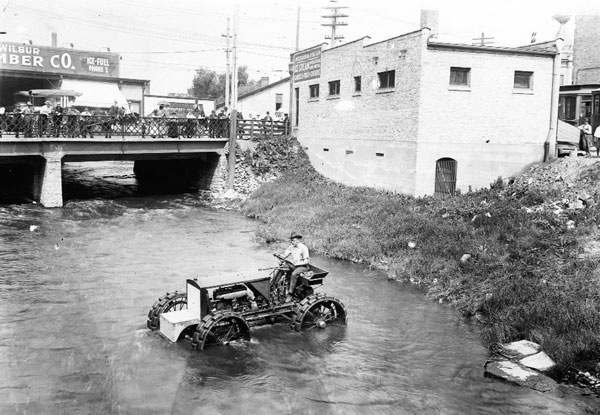 |
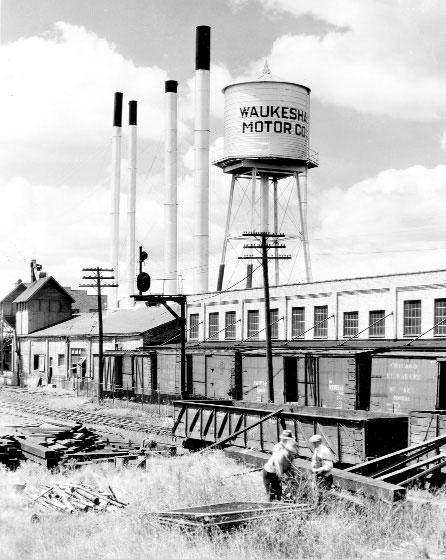 |
| Photo from the John Schoenknecht collection at the Waukesha County Museum | Photo from the Waukesha County Museum |
| A Nilson tractor, built by the Federal Bridge and Structure Co. in Waukesha, complete with a Waukesha motor, was tested in the Fox River at the Madison Street bridge in 1920. | Based on Warren O’Brien’s numbering system, this “back-view” of the Motor Company was taken sometime from the late 1910s to the 1930s.Based on Warren O’Brien’s numbering system, this “back-view” of the Motor Company was taken sometime from the late 1910s to the 1930s. |
The company received a huge order from the International Harvester Co. in March 1921. It was a good deal because of a recession that hit the country after the war. Waukesha Motor Co. saw orders for tractor engines decline and then stop completely. International Harvester ordered 10,000 motors for its tractors. Despite having a signed contract, the deal was renegotiated a year later – the order was cut to 5,000 motors and the delivery time was stretched out until mid- 1923. But Waukesha Motor Co. made it through the recession without having to close.
In 1923, Horning invited James E. DeLong, general production manager of the Indiana Truck Corp., to join the company. That firm had bought motors from Waukesha. DeLong had a long career with the company, but was excited to be a part of Waukesha Motor. Harry Horning assigned him the job of field sales manager. In that capacity DeLong set about convincing oil-field drillers to abandon their inefficient and difficult steam engines for the more compact and reliable gasoline Waukesha power engines. DeLong applied a strategy of direct marketing by sending materials directly to the field supervisors of the oil farms. When the Waukesha Motor salesman made a call, the boss was familiar with the product. Thus, Waukesha Motor entered the field of oil production by supplying the power for the oil rigs that dotted the South and West areas of the U.S. It was a brand-new and profitable market.
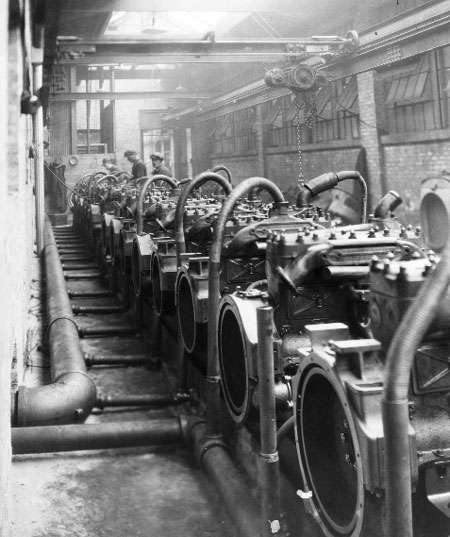 |
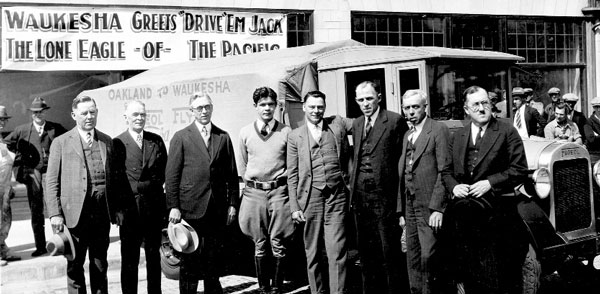 |
| Photo from the Waukesha County Museum | |
| From Michael Goc’s book “Facing Forward”: “The Lone Eagle” “Waukesha developed a close relationship with the Fageol Truck Company of Oakland, California in the 1920s.To promote the collaboration,‘Drive-em Jack’ drove his Fageol from Oakland to Waukesha.Taking advantage of the publicity generated by the trans-Atlantic airplane flight of ‘Lone Eagle’ Charles Lindbergh in 1927, and even though he never left the ground,‘Drive ’em Jack’ became ‘The Lone Eagle of the Pacific.’” Here he posed (fourth from left) in front of the Avalon Hotel on May 2, 1928. Next to him is Les Hood, service manager of the Fageol Truck and Coach Company. Harry Horning is on the right. | |
| Photo from the John Schoenknecht collection at the Waukesha County Museum | |
| One wing of the Waukesha Motor test room as seen April 27, 1927. | |
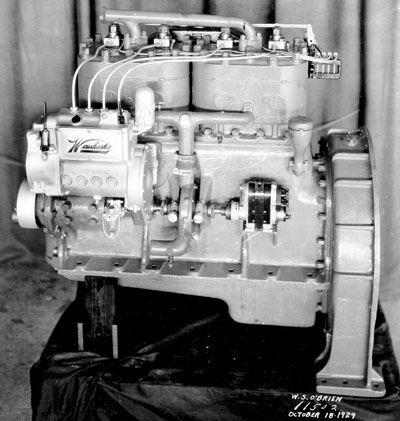 |
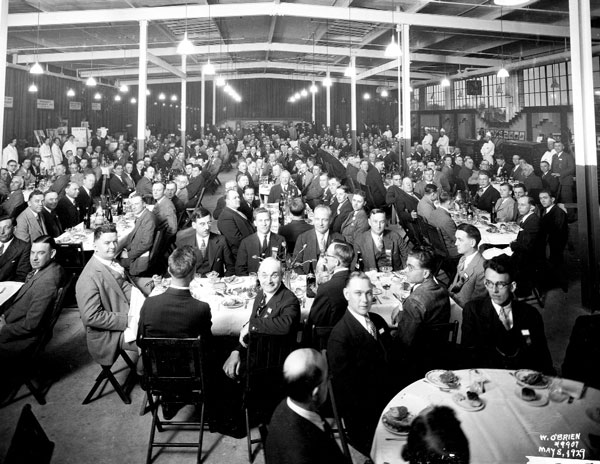 |
| Photo from the Waukesha County Museum | Photo from the Waukesha County Museum |
| Model DWL, 1929/1930 – This is the first diesel. | May 8, 1929 - A banquet held in the Waukesha Motors building. |
Another market for Waukesha Engines in the arid southern and western areas was irrigation. Pumps needed to be supplied with power so that they could move water to the fields. The motors also supplied power for digging water wells.
Self-contained generators with Waukesha motors ran portable lighting systems for everything from remote airfield markers to fire trucks.
As buses began replacing electric streetcars, Waukesha Motors built the powerful engines that ran the buses.
Horning takes over
Horning was elected president of Waukesha Motor Co. in 1925 to succeed Conrad A. Haertel. Horning hired a professional and competent staff, including such men as C.P. Ross, J.B. Fisher, Grant Swain, A.S. Cronk, Arthur Pope, Charles E. Nelson and a score of others. According to Gib Koenig:
“Horning’s eminence in the automotive field brought him many honors and made him a world figure. He was named president of the Society of Automotive Engineers and became an honorary life member. He belonged to the English Automobile Engineers and contributed to their sessions. He served as the first president and as a director of the Internal Combustion Engine Institute, American Petroleum Institute and National Association of Manufacturers.”
In October, 650 employees were given the day off to attend the Carroll College- Lawrence University game in Appleton. Waukesha Motors provided two trucks to carry Carroll co-eds to the game.
Horning continued his scientific interests when he spoke to friends of the Women’s Club at the Baptist Church. He assembled a small electrical device from parts that showed his voice as an electrical signal. Thus, the audience was able to “see” his voice and understand how radio worked.
The July 25, 1925, Freeman carried an article that told of the nation’s first “trackless train” that passed through Waukesha. The novel vehicle, a promotional gimmick for MGM movie studios, was more like a luxury bus or motor home, but it was designed to look like a train. It was powered by a Waukesha Model-U motor. As the train traveled down Broadway, it was met at the Five Points by Harry Horning, E.R. Estberg, Conrad A. Haertel and a Freeman reporter. The occasion was memorialized in a famous photo taken by Warren O’Brien, and Harry Horning took movies of the occasion.
The train then headed to the Waukesha Motors plant where employees got a look. Jack Ruch, an employee, was welcomed on board. He rode the train to Los Angeles and was accompanied by spare parts and a great knowledge of how the motor worked.
Rating octane
Perhaps the most impressive and certainly the longest lasting development of the decade was the development of an octane-rating engine. The story was told by Gib Koenig in one of his columns:
“By the mid-1920s, engine and automobile builders launched intensive research into the characteristics of gasoline used as engine fuel. A Cooperative Fuel Research (CFR) Committee was formed nationally, and again Waukesha Motor Co. was designated to take a leading role, under Horning’s direction. An octane-rating engine was developed here to test antiknock qualities of gasoline. The unit was approved by the U.S. Bureau of Standards; Waukesha Motor Co. was the only manufacturer authorized to build it.”
Folks today are still affected by this invention when they select gasoline at the pump.
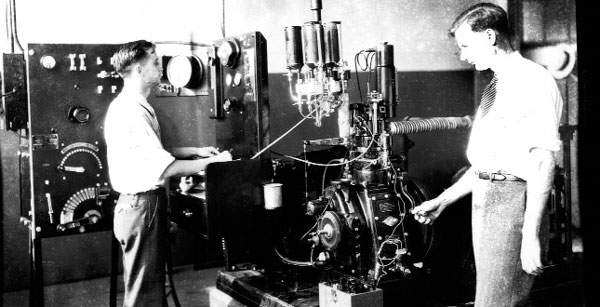 |
| Photo from the John Schoenknecht collection at the Waukesha County Museum |
| This Sept. 2, 1932, photo by Warren O’Brien was labeled “Professor working on fuel research.” The man on the right is believed to be Howard Wiles, the man who had the original prototype that today is displayed at the Waukesha Engine Historical Society. |
Horning was an important member of the CFR group. He hired a man named Arthur Pope who developed the engine used in testing. Pope was able to design an engine that was flexible enough to measure different types of fuel.
The CFR group liked Pope’s idea and directed Horning to build a prototype for the next meeting of the Society of Automotive Engineers. Horning then gave the task to his chief engineer, James B. Fischer, who along with Pope and several other men built the prototype. One of the those involved was named Howard Wiles, who took the prototype home with him when he retired. He later returned it to the company and it is on permanent display in the museum – a truly remarkable piece of machinery. The company was soon making CFR motors for oil and automobile companies, and thousands of them have been shipped around the world. Waukesha Motor Co. still holds the patent and rights to the motor. In addition, the company developed many other types of testing engines.
When the stock market crash happened in 1929, Waukesha Motor was in the midst of issuing a second round of public stock. It was also experimenting with an automotive motor that used diesel fuel. Both projects came to a halt as the Depression hit.
The 1930s
During the early years of the decade, Waukesha Motors’ income fell from $1.8 million to the first deficit ever recorded (of $123,000) in 1933. Office personnel, including Harry Horning, took a 10 percent pay cut and two weeks’ leave.
But because the company made motors for many different applications, it was assured of some business. Michael Goc wrote that “with a little bit of business from here, a little bit from there, Waukesha could make it until conditions improved.”
One of the innovations the company tried was entering into the refrigeration market. It developed a gasoline powered, self-contained refrigeration unit for use on farms and homes without electricity. The unit made a 12-pound block of ice that could be placed in an icebox. The company even considered using the face of Harry Horning as an advertising spokesman, but nixed that. A demonstration vehicle that toured the country promoting the product was produced. The refrigeration unit was located in the old Jiffy-Jell plant on Elizabeth Street, but was discontinued after about one year. But all was not lost.
In 1935, Waukesha’s refrigeration division was converted to the railway division. In the 1930s railroads developed luxury passenger cars to compete with autos. The cars needed to be cooled, so Waukesha Motor developed an under-the-car air conditioner that ran on its own (not reliant on the diesel engine). This led to refrigerated boxcars, trucks, and units for industrial and commercial use – all powered by a Waukesha engine. The most popular were the Model FC and the 15-horsepower Model ICK, which was the smallest four-cylinder engine.
The engineering department turned out designs at a dizzying pace. Many new models were introduced in the 1930s – from four-cylinder motors to six-cylinder, fueled by gasoline, diesel, and natural gas. “By 1935, Waukesha had one-hundred-twenty engine models in its catalog,” wrote Michael Goc.
One very successful engine was the Hesselman. The engine was based on a Swedish patent. It came in a variety of sizes and configurations, but its distinguishing characteristic was its ability to run on different fuels without losing power or self destructing. Some advertised fuels sources were home diesel fuel, heating oil, kerosene or other distillants, natural gas, or even a mixture of gasoline and lubricating oil.
(John Schoenknecht can be reached at thbolt@wi.rr.com.)
This article was originally published in the Friday, January 24, 2014 issue of The Freeman Waukesha County's newspaper.
Copyright © 2014 Waukesha Engine Historical Society, Inc. All rights reserved
